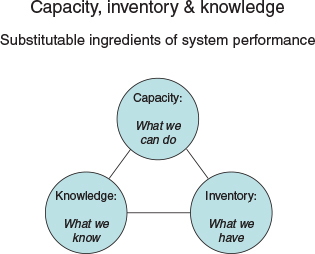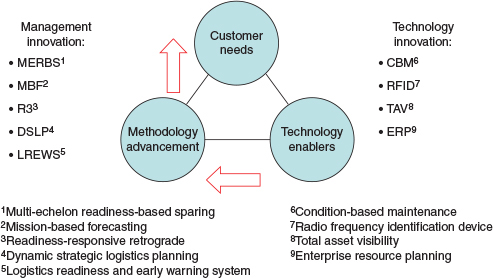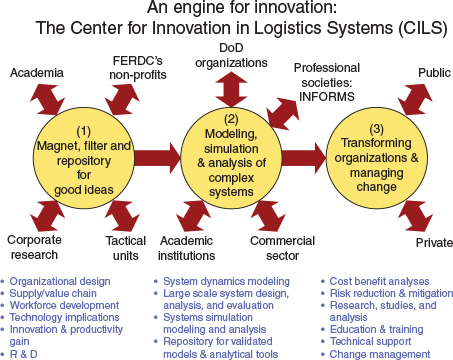Management Innovation as a Strategic Technology
During most of its existence, the operations research community has been “cursed” with both data challenges and computational power (e.g., Bellman’s “curse of dimensionality” in dynamic programming). But that is clearly changing in this new digital technology era of big data. Indeed, data has become ubiquitous; the challenge now is to somehow make sense of it all. And just as diminishing returns finally seemed to be dampening Moore’s Law on computing power, Los Alamos National Laboratory demonstrated the first supercomputer to achieve a petaflop of sustained performance—a million, billion calculations per second and 1,000 times faster than the existing teraflop standard.1 And in September 2013, Stanford University researchers announced the creation of a computer using carbon nanotubes that may further improve performance by an order of magnitude over silicon chips.
So, these twin banes of operations research’s past, data and processing power, are now far more likely to offer opportunities than to hinder future work in this area. The link between big data and analytics has already been established; namely, the extensive use of data, statistics, and quantitative algorithms for descriptive (explanatory), predictive (forecasting), and prescriptive (optimization) modeling and analyses for fact-based, analytic management. And through sensor technology, radio frequency identification, Total Asset Visibility, enterprise resource planning systems, and the Internet, information technology has now expanded to capture, track, monitor, and visualize data in near-real time across disparate, dislocated entities comprising an entire enterprise.
However, the Army has yet to fully integrate analytical architectures into its persisting enterprise system challenges. Complementary decision-support systems have not yet been developed that could capitalize on available enterprise data and, using analytically based methods, make sense of it all, enable improved decisions, and dramatically improve enterprise performance.
For a fixed demand, the three quantities shown in Figure F-1 (inventory, capacity, and knowledge) represent a trade space: If more of one of these quantities is available, then less of one (or both) of the others is necessary to reach the same level of system performance. This trade-off suggests a fundamental truth: If the amount and timeliness of useful data and good information for actionable decisions improves (i.e., increased knowledge), then with the same capacity for action, it now becomes possible to improve system performance with fewer resources.
For large, complex organizations, the greatest return on investment is derived from integrating relevant analytical tools and analysis with the appropriate information technology to provide actionable decisions support. This path achieves cost-effective, performance-oriented results aligned with strategic plans, organizational vision, and ultimately, the purpose for which the enterprise exists. The goal should be the effective integration of analytics into organizational decision-making.
Improvements in data storage and processing continue at a rapid pace, but most organizations struggle to manage, analyze, apply, and transform data into useful information for knowledge creation and actionable decision options. The corporate world has come to realize that investment in new information technology systems, without first examining and implementing the necessary business process changes, simply automates existing inefficiencies and results in negligible benefits. The term
________________________
1Additional information on Reaching for New Computational Heights with Sequoia is available at str.llnl.gov/july-2013/mccoy. Last accessed on September 22, 2014.

FIGURE F-1 Transformational analytics: Capacity, inventory, and knowledge. SOURCE: Adapted with permission of Business Expert Press LLC, from Parlier (2011), permission conveyed through Copyright Clearance Center, Inc.
business intelligence is now used to encompass both analytics and the data processes and technologies used for collecting, managing, and reporting decision-oriented information. Nonetheless, analytic management is often impeded by organizational pathologies: conventional wisdom crowds out critical thinking; high-level managers fail to demand rigor and dispassionate analysis; and organizations lack the capacity for empirical work. What must be created is the analytical capacity for insight, refinement, and better decision-making.
Although studies linking analytical approaches and business performance are still relatively immature, one must be wary of so-called information technology solutions. It is imperative to realize that information systems, especially enterprise resource planning systems, must be connected to analytics in order to create decision support capabilities. There is mounting evidence (e.g., Davenport and Harris, 2007; Ferguson et al., 2005) that the true gains are not obtained just by procuring information technology solutions, but rather by the organizational capacity to create insight and decision options from the information and improved situational awareness provided by information systems technologies. Figure F-2 shows some of the components of an effective management innovation technology system.
Although information technology solutions have ubiquitous appeal (and enormous investment levels), focusing only on information technology results in growing complexity and information overload that exceeds the interpretive capacities of the organizations responsible for developing and using information technologies. Organizations need the analytical, integrative power of operations research to focus business process reengineering on desired outcomes. This has been termed the ingenuity gap (Homer-Dixon, 2000). A complementary relationship, both symbiotic and synergistic, is needed between decision support systems and management information systems.
Two distinctly different planning approaches can be distilled from the management literature: (1) the traditional, or incremental approach and (2) a transformational perspective. The traditional approach focuses on a short-term horizon, usually annual, where internal budget constraints and financial targets constitute the primary management objectives to defend and extend existing business. For stable environments with growing market potential, this familiar incremental approach can yield steady business growth. In contrast, the transformational perspective focuses on penetrating other, perhaps emerging,

FIGURE F-2 Management innovation for improved logistics decision-making.
SOURCE: Republished with permission of Business Expert Press LLC, from Parlier (2011), permission conveyed through Copyright Clearance Center, Inc.
markets and creating new ones. This externally focused approach views environmental conditions and future challenges as potential opportunities rather than constraints to existing business. Because past performance is now irrelevant as a benchmark for planning objectives, an organizational vision must be imagined for a future horizon, and creative plans developed to engineer progress toward this future vision. In this sense, transformational strategic planning requires “imagineering”—that is, leading from the future—by pulling the organization forward, rather than pushing it by managing to the past.
Key ingredients for successfully pursuing a transformational strategy include an engine for innovation and strategic architectures for analysis, management, and planning. An engine for innovation is a virtual test bed that can provide a synthetic, nonintrusive environment for experimentation and evaluation of innovative ideas and concepts. This synthetic environment guides and accelerates transformational change along cost-effective paths, providing the analytical “glue” to integrate and focus what otherwise would be disparate initiatives and fragmented research efforts. In essence, such a capability functions as an engine for innovation to sustain continuous performance improvement.
The organizational construct for an engine for innovation is shown in Figure F-3. The construct includes the following three main components:
1. A research model and supporting framework, including a strategic outreach mechanism, to function as a generator, magnet, conduit, filter, clearinghouse, and database for good ideas;
2. A modeling, simulation, and analysis component that contains a rigorous analytical capacity to evaluate and assess potential impacts and associated costs of good ideas; and
3. An organizational implementation component to enable the transition of promising concepts into existing organizations, agencies, and companies by providing training, education, technical support, and risk reduction and mitigation methods to reduce operational and organizational risk during periods of inevitably disruptive transformational change.
Within the U.S. Army, tactical units are renowned for pioneering and refining the after-action review concept as a continuous learning method to uncover, diagnose, and correct deficiencies that improve and

FIGURE F-3 An organizational construct for an engine for innovation.
SOURCE: Adapted with permission of Business Expert Press LLC, from Parlier (2011), permission conveyed through Copyright Clearance Center, Inc.
sustain operational excellence. Yet, comparable diagnostic effort has not been prevalent at strategic levels within the institutional Army logistics bureaucracy. Because analytically rigorous root cause analysis and understanding of problems and effective response for management issues are not routinely performed at the strategic level to uncover ground truth and learn from mistakes, reactive crisis management seems to be the institutional response to visible symptoms. In other words, the institution is always reacting to logistics problems rather than getting ahead of them.
Institutional adaptation and agility requires a culture of innovation. However, sources for innovation must exist for the culture to embrace. An engine for innovation would provide a source of innovation by building a capacity for low-risk, low-cost experimentation using a synthetic environment where analytically rigorous cost-benefit analyses can be performed to differentiate between desirable objectives and attainable ones that can actually be implemented.
The purpose of this deliberate, cyclical discovery process is to sustain continuous improvement through experimentation, prototyping, field testing, feedback, and especially through rigorous analysis. Organizational vision and analytical tools must not be viewed as mutually exclusive paradigms. Rather, analytical tools should link organizational vision to operational results by defining and monitoring metrics tied to strategic enterprise objectives and aligning incentives to those objectives. In organizations with strong cultures, especially the military services, it is critical that incentives for behavior and performance be carefully and thoughtfully targeted to attain desired institutional outcomes.
Also, strategic planning and management frameworks are essential to enable learning within organizations and to ensure that strategies pursued achieve intended operational results. Strategic architectures for analyses, management, and planning visually portray relationships between system-wide goals, supporting objectives, and strategies to pursue these objectives. They also illuminate the need for adaptation and change by providing mechanisms to sense the need for reacting to, as well as creating, change when necessary.
Strategy, then, is fundamentally about dealing with change. It represents the heart of management. Despite the inexorable advance of technology (both physics-based and information-based), it will be improved decision support systems for enterprise management, pursuing future-oriented visions linked by transformational strategic plans, that ultimately enables the potential of innovation to be realized.
Applying the power of operations research, advanced analytics, and management innovation for dramatic performance improvement, including cost savings on the order of many billions of dollars, could provide enormous efficiency impacts at a crucial time. Current work by TASC suggests that costs savings are indeed possible (Parlier, 2011). Advanced analytics can provide engines for innovation that generate and sustain continuous improvement in demanding, increasingly resource-challenged environments. Recognizing these needs and then developing the capacity to achieve them are the first steps toward demonstrating management innovation as a strategic technology for our defense enterprise bureaucracies and, perhaps, the broader national security community.
It will be improved decision support systems for enterprise management, pursuing future-oriented visions linked by transformational strategic plans, which ultimately enable the potential of innovation to be realized. The concept of management innovation as a strategic technology can be a leading source of innovation and a crucial enabler for sustaining continuous improvement in increasingly resource-challenged environments.
OBSERVATIONS
In this era of dramatic resource constraints, the Army logistics community needs to better harness and apply operations research and strategic analytics across the materiel enterprise. To this end, the Army would find it useful and helpful to develop an engine for innovation for the logistics community and adopt, apply, and refine management innovation as a strategic technology.
REFERENCES
Davenport, T.H., and J.G. Harris. 2007. Competing on Analytics: The New Science of Winning. Boston, Mass.: Harvard Business Review Press.
Ferguson, G., S. Mathur, and B. Shah. 2005. Evolving from information to insight. MIT Sloan Management Review 46(2): 51-58.
Homer-Dixon, T. 2000. The Ingenuity Gap: How Can We Solve the Problems of the Future? New York, N.Y.: Alfred A. Knopf.
Parlier, G.H. 2011. Transforming U.S. Army Supply Chains: Strategies for Management Innovation. New York, N.Y.: Business Expert Press.





